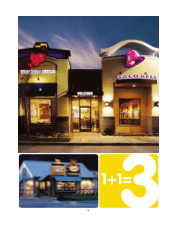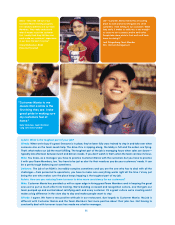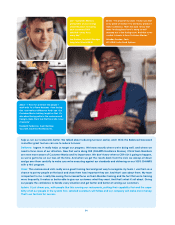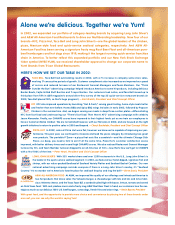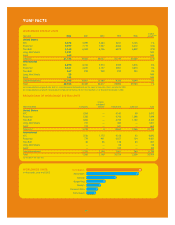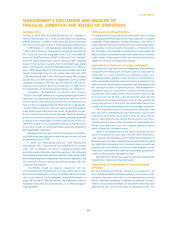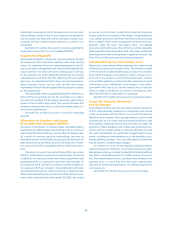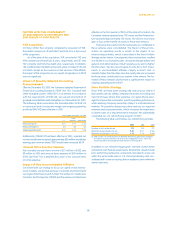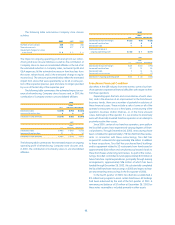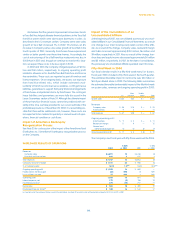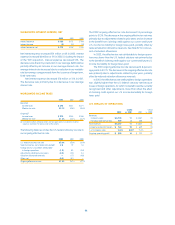Pizza Hut 2002 Annual Report Download - page 31
Download and view the complete annual report
Please find page 31 of the 2002 Pizza Hut annual report below. You can navigate through the pages in the report by either clicking on the pages listed below, or by using the keyword search tool below to find specific information within the annual report.
MANAGEMENT’S DISCUSSION AND ANALYSIS OF
FINANCIAL CONDITION AND RESULTS OF OPERATIONS
29.
Yum! Brands Inc.
INTRODUCTION
On May 16, 2002, TRICON Global Restaurants, Inc. changed its
name to YUM! Brands, Inc. in order to better reflect our expanding
portfolio of brands. In addition, on the same day, Tricon Restaurants
International changed its name to YUM! Restaurants International.
YUM! Brands, Inc. and Subsidiaries (collectively referred to as
“YUM” or the “Company”) comprises the worldwide operations of
KFC, Pizza Hut, Taco Bell, Long John Silver’s (“LJS”) and A&W All-
American Food Restaurants (“A&W”) (collectively “the Concepts”)
and is the world’s largest quick service restaurant (“QSR”) company
based on the number of system units. LJS and A&W were added
when YUM acquired Yorkshire Global Restaurants, Inc. (“YGR”) on
May 7, 2002. Separately, KFC, Pizza Hut and Taco Bell rank in the
top ten among QSR chains in U.S. system sales and units. With
11,798 international units, YUM is the second largest QSR company
outside the U.S. YUM became an independent, publicly owned
company on October 6, 1997 (the “Spin-off Date”) via a tax-free dis-
tribution of our Common Stock (the “Distribution” or “Spin-off”) to
the shareholders of our former parent, PepsiCo, Inc. (“PepsiCo”).
Throughout Management’s Discussion and Analysis
(“MD&A”), we make reference to ongoing operating profit which
represents our operating profit excluding the impact of facility
actions net loss (gain) and unusual items income (expense). See
Note 7 to the Consolidated Financial Statements for a detailed dis-
cussion of these exclusions. We use ongoing operating profit as
a key performance measure of our results of operations for pur-
poses of evaluating performance internally. Ongoing operating
profit is not a measure defined in accounting principles generally
accepted in the United States of America and should not be con-
sidered in isolation or as a substitute for measures of performance
in accordance with accounting principles generally accepted in
the United States of America.
All references to per share and share amounts in the follow-
ing MD&A have been adjusted to reflect the two-for-one stock split
distributed on June 17, 2002.
In 2002, our international business, YUM! Restaurants
International (“YRI” or “International”) accounted for 35% of system
sales, 31% of revenues and 32% of ongoing operating profit
excluding unallocated and corporate expenses. We anticipate
that, despite the inherent risks and typically higher general and
administrative expenses required by international operations, we
will continue to invest in certain international markets with sub-
stantial growth potential.
This MD&A should be read in conjunction with our
Consolidated Financial Statements on pages 44 through 47 and
the Cautionary Statements on page 43. All Note references herein
refer to the Notes to the Consolidated Financial Statements on
pages 48 through 72. Tabular amounts are displayed in millions
except per share and unit count amounts, or as otherwise specif-
ically identified.
CRITICAL ACCOUNTING POLICIES
Our reported results are impacted by the application of certain
accounting policies that require us to make subjective or complex
judgments. These judgments involve estimations of the effect of
matters that are inherently uncertain and may significantly impact
our quarterly or annual results of operations or financial condi-
tion. Changes in the estimates and judgments could significantly
affect our results of operations, financial condition and cash flows
in future years. A description of what we consider to be our most
significant critical accounting policies follows.
Impairment or Disposal of Long-Lived Assets
We evaluate our long-lived assets for impairment at the individual
restaurant level. Restaurants held and used are evaluated for
impairment on a semi-annual basis or whenever events or cir-
cumstances indicate that the carrying amount of a restaurant may
not be recoverable (including a decision to close a restaurant). Our
semi-annual test includes those restaurants that have experienced
two consecutive years of operating losses. These impairment
evaluations require an estimation of cash flows over the remain-
ing useful life of the primary asset of the restaurant, which can be
for a period of over 20 years, and any terminal value. We limit
assumptions about important factors such as sales growth and
margin improvement to those that are supportable based upon
our plans for the unit and actual results at comparable restaurants.
If the long-lived assets of a restaurant on a held and used
basis are not recoverable based upon forecasted, undiscounted
cash flows, we write the assets down to their fair value. This fair
value is determined by discounting the forecasted cash flows,
including terminal value, of the restaurant at an appropriate rate.
The discount rate used is our cost of capital, adjusted upward
when a higher risk is believed to exist.
When it is probable that we will sell a restaurant we write
down the restaurant to its fair value. We often refranchise restau-
rants in groups and therefore perform impairment evaluations at
the group level. Fair value is based on the expected sales proceeds
less applicable transaction costs. Estimated sales proceeds are
based on the most relevant of historical sales multiples or bids
from buyers, and have historically been reasonably accurate esti-
mations of the proceeds ultimately received.
See Note 2 for a further discussion of our policy regarding the
impairment or disposal of long-lived assets.
Impairment of Investments in Unconsolidated
Affiliates
We record impairment charges related to an investment in an
unconsolidated affiliate whenever events or circumstances indi-
cate that a decrease in the value of an investment has occurred
which is other than temporary. In addition, we evaluate our invest-
ments in unconsolidated affiliates for impairment when they have
experienced two consecutive years of operating losses. Our


